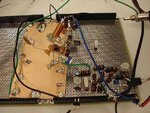neazoi
Advanced Member level 6
hello I have found this schematic
**broken link removed**
This is a video only modulator.
I have made a 5.5MHz FM oscillator and I wish to conect it's output (capacitor coupled) to a point on the video modulator to mix the two signals and achieve a full audio/video modulator.
What should this point be? I have tried the base of the transistor but the result was not so satisfying. the sound affected the video signal too
**broken link removed**
This is a video only modulator.
I have made a 5.5MHz FM oscillator and I wish to conect it's output (capacitor coupled) to a point on the video modulator to mix the two signals and achieve a full audio/video modulator.
What should this point be? I have tried the base of the transistor but the result was not so satisfying. the sound affected the video signal too
